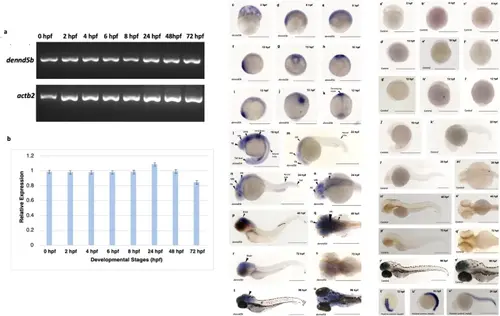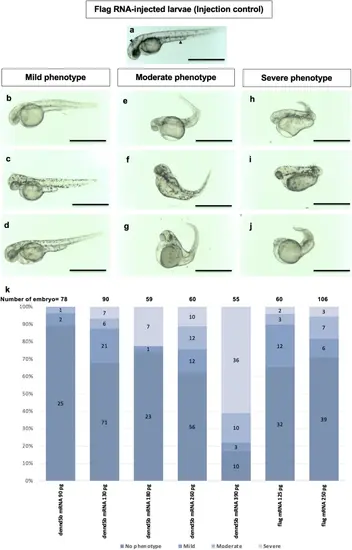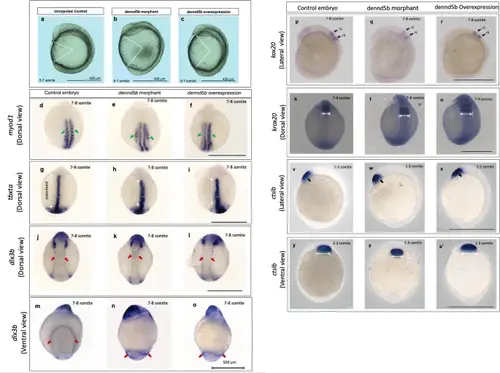- Title
-
Role of DENN Domain-Containing Protein 5b (dennd5b) during early embryonic development of zebrafish
- Authors
- Mendoza, A., Nassar, K.M., Marston, M., Gil, A., Hasan, S.
- Source
- Full text @ Mol. Biol. Rep.
|
Multiple sequence alignments of dennd5b amino acid sequences. a The protein domains of zebrafish Dennd5b, including uDENN, cDENN, dDENN, RUN1, PLAT, and RUN2, are illustrated in a schematic representation. The gray line beneath the schematic denotes the positions of the amino acid residues, while the lighter gray line above the schematic marks the specific locations of the individual domains b The amino acid sequence alignment shows the high level of conservation of DENND5B between humans, chimpanzees, mice, and zebrafish. Amino acids highlighted in black shade indicate conservation of the residue between all proteins, those in grey reflect highly similar residues between proteins. Below the amino acid sequences, the blue line represents the position of the uDENN domain, while the light blue lines indicate the central DENN domain. The light pink line corresponds to the dDENN domain. The dark yellow lines denote the locations of the first RUN domain (RUN1), and the light yellow lines mark the second RUN domain (RUN2). Additionally, the green lines represent the PLAT domain, which separates the two RUN domains within DENND5B c Amino acid sequence alignments between zebrafish dennd5a and dennd5b, and light-yellow lines indicate the locations of the RUN2 domain in zebrafish dennd5b |
|
Temporal and spatial expression of dennd5b during zebrafish embryogenesis. a-b Semi-quantitative RT-PCR analysis of dennd5b expression at 0, 2, 4, 6, 8, 24, 48, and 72 hpf developmental stages. Zebrafish actb2 was used as an internal control for normalization. b Densitometry-based quantification of dennd5b expression levels relative to actb2. Data are normalized to the 24 hpf timepoint and expressed as mean ± SEM from n = 3 replicates. c- v′ Whole-mount in situ hybridization showing dennd5b mRNA expression at various developmental stages. c-e Early development (2–8 hpf). f-h 10 hpf. i-k 7–8 somite stage (12 hpf), expression in developing brain region. l 16 hpf, expression in brain regions including forebrain (FB), midbrain (MB), hindbrain (HB), and developing neural tube and tail bud. m 22 hpf, expression in FB, MB, HB and neural tube. n-o 24 hpf, strong expression in brain regions (HB, MB, FB) with developing neural tube and tail. p-q 48 hpf, prominent brain expression with developing body structures. r-s 72 hpf, continued brain expression in developing larva. t-u 96 hpf, expression maintained in brain regions of free-swimming larva. In situ hybridization of dennd5b with sense probe, which shows no staining. a′ 2 hpf, b′ 6 hpf, c′ 8 hpf, d′-f′ 10 hpf, g′-i′ 12 hpf, j′ 16 hpf, k′ 22 hpf, l′-m′ 24 hpf, n′-o′ 48 hpf, p′-q′ 72 hpf, r′-s′ 96 hpf. t′-v′ Expression of positive control gene myod1 in the somite at 12 hpf, 16 hpf and 24 hpf, respectively. Scale bar 500 μm |
|
MO knockdown of dennd5b indicates its critical role in embryo development. a An uninjected zebrafish embryo at 48 hpf exhibits no observable phenotype. b Zebrafish embryos injected with the standard control morpholino show no signs of physical deformity at 48 hpf. c–e A mild phenotype, f–h a moderate phenotype, and i–k a severe phenotype was observed following dennd5b MO knockdown, underscoring the critical role of dennd5b in early zebrafish embryonic development. The scale bar indicates 890 μm. l A graphical representation illustrates the effects of three different dosages of dennd5b MO injection, demonstrating a dose-dependent increase in phenotypic severity, including a compressed head and deformed tail, as compared to embryos injected with the standard control MO PHENOTYPE:
|
|
Zebrafish dennd5b overexpression resulted in a compressed head and a deformed tail phenotype. a Zebrafish standard control RNA injected embryo showed no major signs of physical deformity (no phenotype) at 48 hpf. b-d A mild phenotype, e-g A moderate phenotype, and h-j A severe phenotype emerged due to dennd5b mRNA injection suggesting its critical role in zebrafish early embryonic development. The scale bar represents 890 μm. k Graphical representation of different dosages of mRNA injection resulted in notable physical deformities of a compressed head and a deformed tail phenotype, which occur in a mRNA dose-dependent manner at 48 hpf |
|
Graphical representation shows partial rescue of MO dose dependent phenotype by injecting a rescue RNA. A bar graph showing the lower dose of MO and rescue RNA injection leads to a reduction in physical deformities specifically mild to moderate phenotypes as observed at 48 hpf |
|
dennd5b plays a role in CE movement. Zebrafish embryos at the one-cell stage were injected with dennd5b MO, and dennd5b mRNA. These embryos were either viewed from the dorsal side, ventral side and or laterally. a-c The angle between the anterior-most and the posterior-most ends of the body axis was measured (scale bar, 420 μm). d-a′ Knockdown or overexpression of dennd5b affects the expression of CE movement-related genes as determined by WISH. The expression pattern of the neuroectoderm marker dlx3b, notochord marker tbxta, somite marker myod1 and rhombomere 3,5 of the hindbrain marker krox20 were determined at 7–8 somite stage (12 hpf). The expression pattern of the prechordal plate marker ctslb was determined at 1–3 somite stage (10–11 hpf) scale bar 500 μm PHENOTYPE:
|






